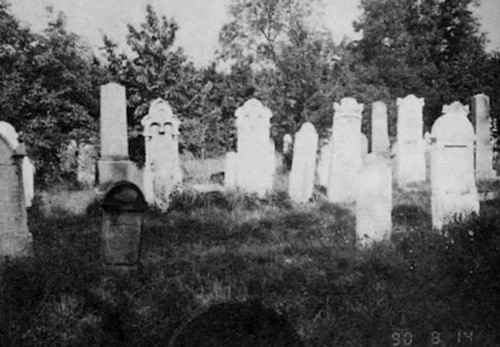 |
(1980)
|
|
[Page 229]
Appendices {contd.}
|
|
| The new cemetery in Sečovce (1980) |
|
|
| The store of M. Selzer in Sečovce |
[Page 230]
|
|
| The main street in Sečovce (1950) |
|
|
| The Schwartz house and Frieder[16] house on the main street (1991) |
[Page 231]
|
[Page 232]
|
|
| Students of the Jewish School in 1935 |
|
[Page 233]
|
|
| A performance of “Queen Esther” in Sečovce (1935) |
|
|
| Students of the school in 1936/37 |
[Page 234]
|
|
| Youth of Sečovce in the 30s |
|
|
| A Sečovce training unit |
[Page 235]
|
|
From right: Shlomo Caspi, Nandi Schwartz, and Shmuel Dovi |
|
|
| Girls of Sečovce Chava (Eliza) Kaufman and Chava Sapir |
[Page 236]
|
|
| Holocaust survivors at a memorial service on Mount Zion |
[Page 237]
|
|
| Holocaust survivors at a memorial service on Mount Zion |
[Page 238]
[Page 239]
[back cover]
|
Born in Slovakia (5673-1913) to parents Rabbi Pinchas and Sarah Frieder, may G-d avenge their blood. He studied in yeshivas and was certified to teach. Serving as principal of the Jewish school in Nové Mesto in the years of hardship[23] and the Holocaust, he was the right hand of his brother, Rabbi Abraham Abba z”l, who worked tirelessly to save Jews.
From 1946-1949 he served as head of the “Organization of the United Jewish Communities of Slovakia” and dealt with the restoration of communities by aiding the immigration of Jews to Eretz Yisrael and transporting thousands of survivors from Hungary through Slovakia to Israel. Due to his Zionist activities, he was even arrested and spent a number of months in jail. These stories were published in his book “To Deliver Their Souls” (Holocaust Library, New York 1991).
With his aliyah to Israel he settled in Netanya and continued to devote himself to education. He founded and led four schools, among them the religious vocational high school “Shapira,” which today numbers more than a thousand students. Through his life of educational activities, he won the Education Prize.
In Netanya, Emanuel Frieder also continued his communal activity. He served as a city council member and as assistant head of the religious council, on whose behalf he even published a series of educational materials about Israeli holidays and festivals.
Because he was president of the Union of Czechoslovak Expatriates in Israel and a past teacher in Sečovce, Emanuel Frieder was asked to write and edit this book, that is published on the initiative of the Organization of Expatriates of Sečovce.
This book serves as testimony and memory to uphold, as it is said, “remember what Amalek did to you” (Deuteronomy 25:17), “inscribe this in a document as a reminder, and read it aloud to Joshua” (Exodus 17:14).[24]
Translator's Footnotes:
|
|
JewishGen, Inc. makes no representations regarding the accuracy of
the translation. The reader may wish to refer to the original material
for verification.
JewishGen is not responsible for inaccuracies or omissions in the original work and cannot rewrite or edit the text to correct inaccuracies and/or omissions.
Our mission is to produce a translation of the original work and we cannot verify the accuracy of statements or alter facts cited.
 Sečovce, Slovakia
Sečovce, Slovakia
 Yizkor Book Project
Yizkor Book Project
 JewishGen Home Page
JewishGen Home Page
Copyright © 1999-2024 by JewishGen, Inc.
Updated 22 Feb 2023 by JH